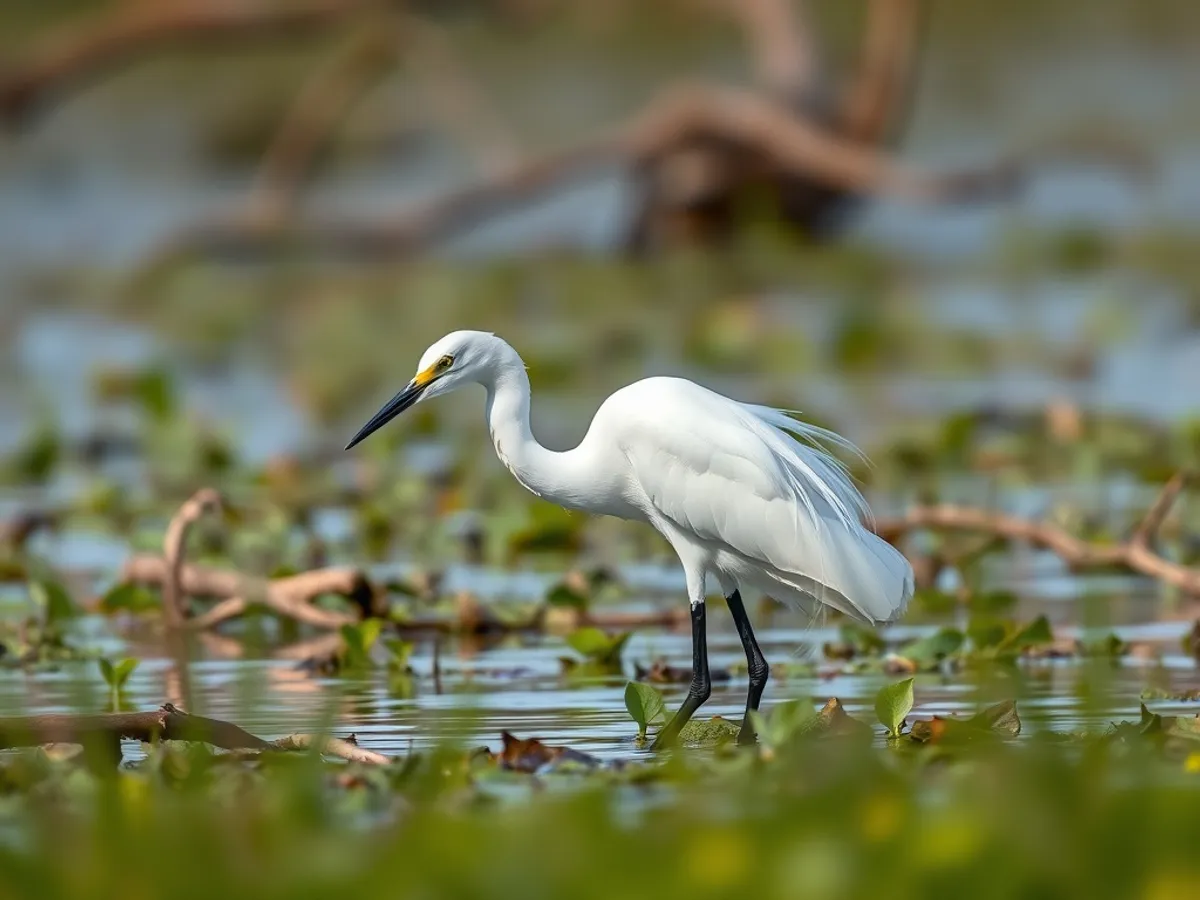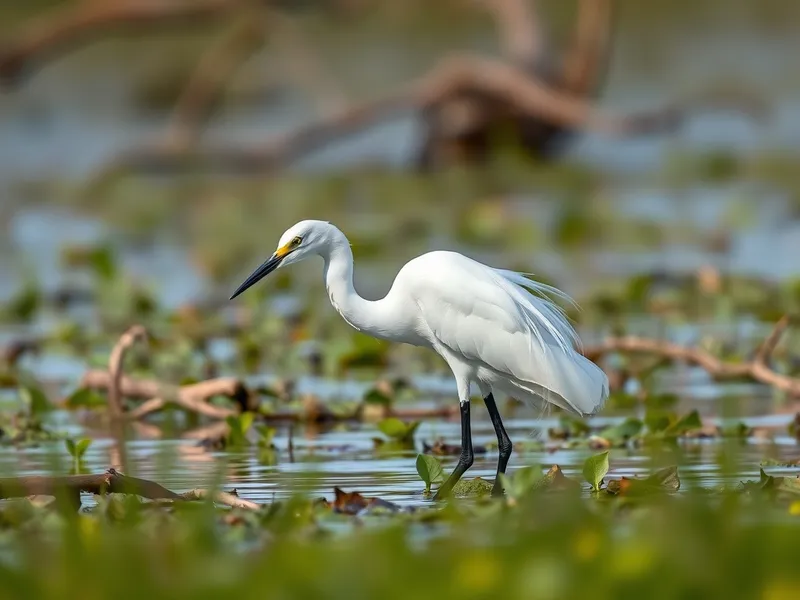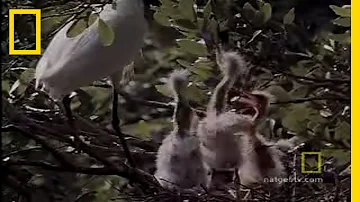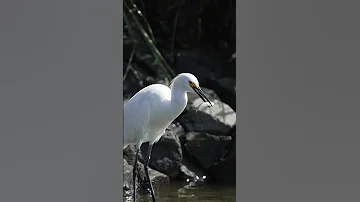
Snowy Egret
Egretta thula

Meet the Snowy Egret
The Snowy Egret is a striking medium-sized white heron known for its elegant appearance and graceful movements. It features brilliant white plumage, a slender black bill, long black legs, and vivid yellow feet, which it uses to stir up prey in shallow water. Snowy Egrets are highly social birds often seen wading in wetlands, marshes, and along shorelines in search of small aquatic animals. Their distinctive breeding plumes were once highly sought after, leading to significant population declines before conservation measures were enacted. Today, they are a familiar sight across North and South America, especially in suitable wetland habitats.
Classification
Bird
Habitat
Wetlands
Diet
Carnivore
Lifespan
5-15 years
Conservation
Least Concern
Weight
350-400 g
📖Fascinating Facts
Elegant Appearance
Snowy Egrets are easily recognized by their pure white feathers, slim black legs, and striking yellow feet.
Expert Hunters
They use their bright yellow feet to stir up mud and flush out small fish, crustaceans, and insects from shallow water.
Conservation Success
After being nearly wiped out for the plume trade, Snowy Egrets made a remarkable comeback due to strict protection laws.
📋Detailed Description
The Snowy Egret (Egretta thula) is a medium-sized heron, measuring 56–66 cm (22–26 in) in length with a wingspan of 100–105 cm (39–41 in) and weighing approximately 370 g (13 oz). Its plumage is entirely white, with delicate, lacy plumes (aigrettes) on the head, neck, and back during the breeding season. The slender, black bill is sharply pointed, ideal for spearing small prey, and contrasts with the lores (skin between the eyes and bill), which turn bright red during courtship. The legs are long and black, while the feet are a vivid yellow, a distinctive feature that aids in foraging. Snowy Egrets have keen eyesight, allowing them to hunt efficiently in shallow waters. Their neck is S-shaped, facilitating rapid extension to strike at prey. In flight, they display slow, deliberate wingbeats and retract their necks, typical of herons. Juveniles resemble adults but have duller legs and feet, sometimes with more greenish tones. The species is highly gregarious, often nesting and feeding in large colonies, sometimes with other heron species. Their vocalizations are generally soft, consisting of croaks and squeaks, but become more pronounced during breeding displays.
💡 Did you know?
At the turn of the 20th century, Snowy Egrets were nearly hunted to extinction for their beautiful plumes, which were used to decorate ladies' hats.
🔬Research & Sources
Wikipedia Summary
The snowy egret is a small white heron. The genus name comes from Provençal French for the little egret, aigrette, which is a diminutive of aigron, 'heron'. The species name thula is the Araucano term for the black-necked swan, applied to this species in error by Chilean naturalist Juan Ignacio Molina in 1782.
Last Modified: 6/4/2025
🎭Behavior & Social Structure
Snowy Egrets are diurnal and spend much of the day foraging in shallow wetlands, tidal flats, and estuaries. They employ a variety of hunting techniques, including standing still and waiting for prey, stirring the substrate with their bright yellow feet to flush out fish, or running through water with wings partially spread to herd prey. Their diet consists mainly of small fish, crustaceans, insects, amphibians, and occasionally reptiles. Socially, they are often seen in loose flocks, especially outside the breeding season, and may form mixed-species feeding groups. Snowy Egrets are territorial during nesting and may display aggressive behaviors, such as bill snapping and chasing, to defend their space. They are known for their elaborate courtship displays, including plume fluffing, head tossing, and aerial chases. Roosting occurs communally in trees or shrubs near water, providing safety in numbers from predators.
👶Reproduction & Life Cycle
Breeding occurs from March to July in North America, varying with latitude. Snowy Egrets are seasonally monogamous, forming pairs each breeding season. Courtship involves elaborate displays, with males showcasing their plumes and performing aerial maneuvers. Nests are constructed in colonies, often with other wading birds, in trees, shrubs, or reed beds over water. Both sexes participate in building the nest, which is a platform of sticks lined with softer materials. The female typically lays 3–5 pale blue-green eggs. Incubation lasts about 22–25 days and is shared by both parents. Chicks are semi-altricial, hatching with down and open eyes, and are fed regurgitated food by both adults. Fledging occurs at 20–25 days, but young may remain dependent on parents for several weeks after leaving the nest.
🛡️Adaptations & Survival
Snowy Egrets possess several adaptations for their wetland lifestyle. Their long legs and toes allow them to wade efficiently in shallow water, while the contrasting yellow feet are used to startle and attract prey. The sharp, slender bill is specialized for rapid strikes at small aquatic animals. Their white plumage provides camouflage against the bright sky when viewed from below by prey. During breeding, ornamental plumes serve as visual signals in mate selection. Behavioral flexibility in foraging, including foot-stirring and cooperative hunting, enhances their ability to exploit various prey types and habitats. Their colonial nesting reduces predation risk and allows efficient use of limited nesting sites.
🎨Cultural Significance
The Snowy Egret has played a notable role in the history of bird conservation, serving as a catalyst for the formation of the Audubon Society and the enactment of protective legislation in the United States. Its elegant appearance and striking breeding plumes made it a symbol of beauty and fragility in nature. In some cultures, egrets are associated with purity, grace, and patience. The species is a popular subject in wildlife art and photography, and is often featured in ecotourism and environmental education programs. There are no known traditional uses of the species in indigenous cultures, but its conservation story is widely cited in environmental advocacy.
🔬Recent Research & Discoveries
Recent research on Snowy Egrets has focused on their foraging ecology, the effects of environmental contaminants (such as mercury and pesticides) on reproductive success, and their responses to habitat modification. Studies using stable isotope analysis have provided insights into their diet and trophic relationships. Genetic analyses have clarified their relationships within the Egretta genus and have identified low levels of genetic differentiation across their range, suggesting high dispersal ability. Ongoing monitoring programs track population trends and inform wetland management practices. Climate change impacts, particularly sea level rise and altered hydrology, are current subjects of ecological modeling and conservation planning.
🎥Wildlife Videos

Animal Winter Games: Snowy Egret Tug of War | National Geographic
About National Geographic: National Geographic is the world's premium destination for science, exploration, and adventure.
National Geographic

Snowy Egret ||
Snowy Egret || #birds #nature #animals.
Green birds in our Planet

Snowy Egret
Do you know the Snowy Egret? I invite you to watch this short video so that you can learn how to differentiate it from other white ...
Victoria Restrepo Nature Documentaries

Conservation Success Stories: The Snowy Egret
Hello and welcome to the CAC series on conservation success Stories this Story Will focus on the Snowy egret It is thought that in ...
Canisius Ambassadors for Conservation

Great egret hunting fish | Beautiful wildlife videos | Animal Documentaries | Wildlife History
wildlife #birds #nature.
Divine Wildlife

Snowy egret devouring a fish 🐟!!!
Snowy egret devouring a small fish shot on a Sony A1 and 200-600 #wildlife #wildlifeshorts #birds #shorts #sonyalpha #fishing.
Sam Rino
🌍Habitat Information
The Snowy Egret typically inhabits Wetlands environments. Snowy Egrets have adapted to their environments with specialized features and behaviors.
Primary Habitat:
Wetlands
More detailed habitat information will be available soon.
🛡️Conservation Status
The Snowy Egret is currently classified as Least Concern. Conservation efforts are crucial for preserving this species for future generations.
Common Threats:
- 🏠Habitat loss and fragmentation
- 🌡️Climate change impacts
- 🎯Hunting and poaching
- 🏭Human-wildlife conflict
⚠️Threats & Conservation Challenges
Historically, Snowy Egret populations were severely impacted by plume hunting in the late 19th and early 20th centuries, as their breeding plumes were highly valued in the fashion industry. Legal protection and conservation efforts have allowed populations to recover. Presently, habitat loss and degradation due to wetland drainage, pollution, and human disturbance are the primary threats. Pesticide contamination and climate change, affecting water regimes and prey availability, also pose risks. Although currently listed as Least Concern by the IUCN, local declines may occur in areas with significant habitat alteration. Conservation challenges include maintaining wetland quality and connectivity, and mitigating human impacts.
🔬Scientific Classification
Scientific Name
Egretta thula
Classification Hierarchy
🔍 About Taxonomic Classification
Taxonomic classification is a hierarchical system used by scientists to classify and organize living organisms based on shared characteristics and evolutionary relationships.
The system moves from broad categories (Kingdom) to increasingly specific ones, with each animal's scientific name typically consisting of its Genus and species.
📝Community Notes
Share your observations and insights about the Snowy Egret with our community of wildlife enthusiasts.
Join Our Community
Sign in to share your observations and connect with fellow wildlife enthusiasts.
Sign In to ContributeNo community notes yet
Be the first to share your observations about the Snowy Egret!
Explore Snowy Egret
Select a tab above to learn more about this amazing animal.
📸Photo Gallery
No photos available for this animal yet.
🌟Discover More Wildlife
Continue your journey of discovery with more fascinating animals from our database
